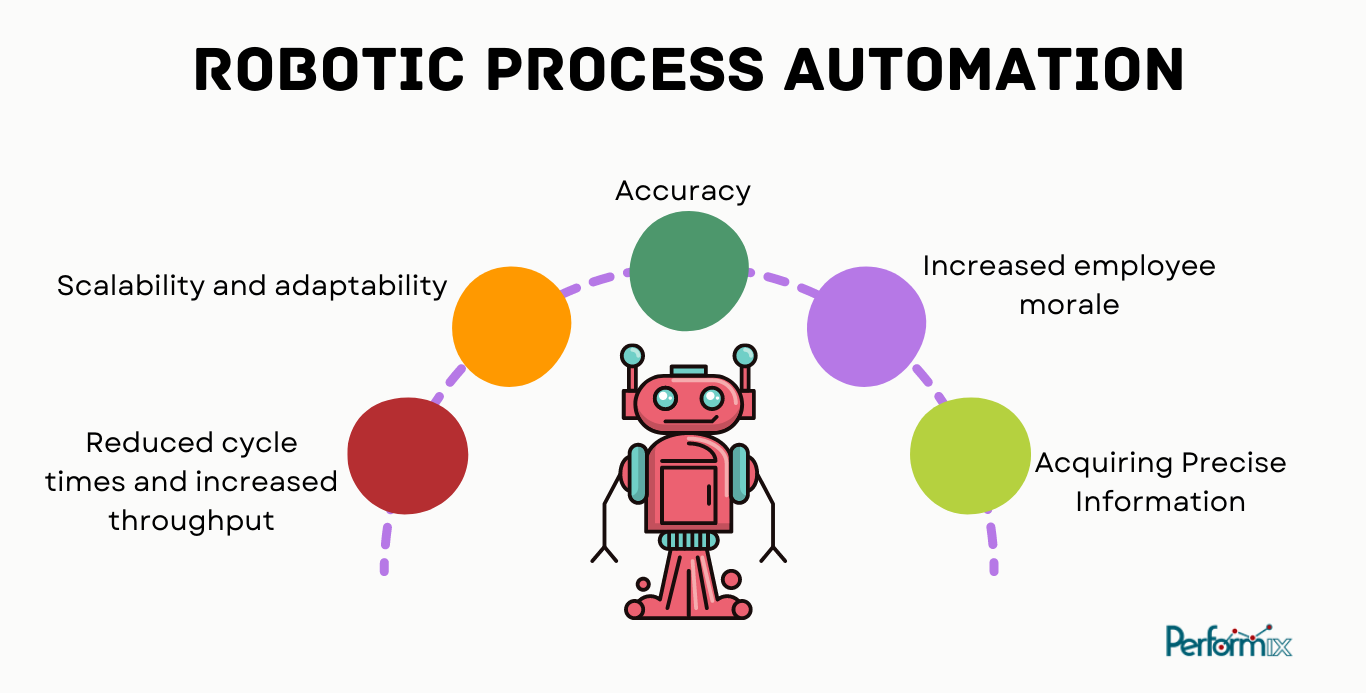Automation in Business Process
How work is mechanized has evolved in tandem with the changing nature of work. Automation of the internal processes of contemporary firms has been primarily enabled by traditional information technology (IT). Numerous firms have incorporated technology into their operations using enterprise resource planning (ERP) and other business tools. However, some of these organizations still need to run on a mishmash of antiquated methods and software that need to integrate better or facilitate the delivery of actionable information. Though ERP and many software applications aid the operational process, they have limitations.
Nowadays, businesses aren’t content with solutions that only automate processes; they also want those that foster growth, encourage innovation, and help them avoid driving costly expenditures.
Robotic process automation (RPA) is relatively new, with deep roots in business process management (BPM). Over the past decade, RPA systems have gradually matured to the point where large-scale process automation is achievable. Any systematic, standardized, repeatable procedure that follows consistent standards and is carried out entirely through human-machine interaction is likely to be a powerful candidate for robotic process automation (RPA) software robots, which are applicable across a wide range of business functions and industries.
Do you know
Forrester forecasts that in 2023, the economy will reallocate 10% of automation spending from transformation to resilience.
Understanding RPA
Automating rule-based manual tasks associated with repetitive and transactional procedures is the focus of RPA, which is deploying software robots to interface with SaaS (Software as a Service) applications and IT infrastructure. A human-like robot acts out a worker’s interactions with a system’s UI. Without requiring changes to preexisting infrastructure or systems, RPA services ensure the safety of sensitive information and boost productivity across an organization’s many software platforms. RPA is a subset of disciplines like Machine Learning, Automation Engineering, and Artificial Intelligence. Businesses can reduce risk exposure by automating procedures rather than wasting the most valuable human resources on routine, time-consuming operations. More importantly, RPA is for businesspeople who aren’t tech-savvy but would benefit from having technology perform mundane tasks on their behalf.
Do you know
With enterprises already gearing up with RPA, Gartner has reported that 65% of businesses that have already used automation technologies want to include artificial intelligence by 2024. This includes machine learning, algorithms for processing natural language, process mining, task mining, and the intelligent processing of documents.
View recent reports of Gartner on Automation in Business & Market insights of RPA

Organizations can increase their profits, adaptability, and responsiveness by using RPA to standardize their processes. In addition to making workers happier and more invested in their work, this will boost productivity and efficiency by decreasing the amount of time spent on routine tasks. Here it is; how?
- Reduced cycle times and increased throughput: Software robots are built to do jobs more quickly than humans and don’t need breaks for food or sleep, allowing them to work around the clock.
- Scalability and adaptability: Once a procedure has been described as a set of instructions that a software robot can carry out, it can be scheduled for a specific time, and as many robots as needed can be instantly deployed to carry it out. Since most robots can handle a wide variety of tasks, they can be quickly repurposed when a more pressing need arises.
- Accuracy: Due to their strict adherence to programming, greater precision is achieved, making it more reliable and less likely to make mistakes.
- Increased employee morale: Most of the time, the most tedious and unenjoyable parts of a process or activity are the ones best suited for automation; once they are out of the way, workers may devote their time and energy to more valuable and satisfying endeavours.
- Acquiring Precise Information: By keeping track of everything a software robot does, we can learn from its work and use that information to better the process and ensure that it complies with regulations.
RPA as a Service
Robotic process automation as a Service (RPAaaS) allows enterprises to run more efficiently and provide uniform departmental procedures. It helps with better internal communication and coordination and caters to customers’ needs.
Do you know
By 2027, the global RPA market is expected to be worth $11 billion, and more companies are using RPA as part of their digital transformation plans.
To take advantage of RPA’s benefits and capabilities on the cloud without the hassle of installation or licensing, enterprises are increasingly turning to RPA as a service (RPAaaS).
The following are some advantages of using RPAaaS:
- Using the cloud to deploy RPA technology allows for a reduction in associated infrastructure costs.
- There are no hosting or licensing fees.
- No IT specialist is required for bot programming or upkeep.
- The ability to pay for services on a metered basis.
- Reduced deployment time because no unique setup is needed.
- Automatic patching and maintenance for software.

Despite the above merits, there are still obstacles to RPAaaS with its growing popularity and visibility, such as,
1. Data Piracy
When companies use an RPA service provider, they risk giving that company’s clients, employees, and other third parties access to sensitive information.
- However, some privacy legislation, like GDPR (General Data Protection Regulation) and CCPA (California Consumer Privacy Act), cover third-party credentials and permissions. In addition, some service providers show that they follow the rules by getting certifications like ISO 27001 and SOC 2.
- Homomorphic encryption is another tool companies may use to securely store and process data in the cloud without requiring users to decrypt it first.
2. Cloud Challenges
Adoption and uptime are two common problems for cloud-based services.
COVID-19 has accelerated the shift toward cloud computing, but many companies still use on-premises systems to store and manage their data. To use RPAaaS, businesses must first migrate their data to the cloud and configure their infrastructure.
When asked about the average cost of server downtime in 2020, 25% of organizations worldwide said it was between $300,000 and $400,000. However, all cloud-based operations are interrupted in a cloud outage, and no RPAaaS provider can ensure continuous service.
As many enterprises move their operations to the cloud, RPA-as-a-service will rise in vogue over the next few years. Overcoming its challenges will lead to price reductions as more vendors enter the market offering software suitable for enterprises of varying sizes.
Use-case
Telecommunications, banking, customer service, insurance, healthcare, manufacturing, financial services, property management, retail, and information technology are enforcing RPA solutions into their business processes. Here are a few areas of its execution.
- Data entry in modern ERP systems is automated.
- Conducting file-transfer operations
- Submission of an online form
- Screen-based data comparison
- Connecting ERP to external programs and older software
- In-process data automation Extraction of real-time data from screens
- Detecting a deviation from the norm and marking it for further investigation
- In-Depth Analysis of Data
- Controlling the flow of email
- Dealing with Purchase Orders
- Management of Payroll System Processing
- Statistics on Human Resources
Currently, retail and healthcare providers better rapid barometers of economic health with RPA.
Healthcare
A rising proportion of hospital patients favor utilizing RPA to save money and reap enormous benefits for the healthcare business. For instance:
1. Reducing the Human Workforce:
Incorporating RPA frees humans from everyday and repetitive duties, enabling them to devote more time and energy to strategic and creative endeavors.
2. Health care with better quality:
How? By deploying RPA in duo with existing systems, more patient records, updates, data entry processing, and even claims processing can be automated with RPA at lower costs; this makes healthcare staff focus on personalized personal care for massive numbers of patients.
Retail
Automating processes like 24/7 inventory monitoring, customer engagement, bill creation, customer complaint management, company reporting, and data extraction to locate crucial information from manufacturers, marketing departments, Etc., is made possible by this enterprise-grade software. For instance:
- Implementing RPA in the retail supply chain can reduce manufacturing costs and increase profit margins for retailers across the board.
- As the volume of online purchases continues to rise, retailers need a streamlined method of handling administrative activities to keep up with customer demand.
AI (Artificial Intelligence) is often confused with RPA, so let’s clarify it.
What’s the difference between RPA and AI?
RPA and AI are not the same, but when combined, the potential for businesses of all sizes explodes. RPA technology can teach RPA robots complex AI abilities such as machine learning models, NLP, character and picture recognition, and more. Equipping robots with such AI capabilities increases their capacity to handle cognitive tasks requiring things considerably.
1. Deciphering texts, even those were containing semi- or unstructured data.
2. Imagining computer interfaces (including virtual desktops)
3. Understanding spoke the language and engaging in verbal exchanges.
Many businesses see RPA as the ‘last-mile’ delivery mechanism for AI, which is especially useful as organizations rush to incorporate technology into front-line activities and decisions. Implementing machine intelligence into routine tasks is now possible through robots that can be programmed to use machine learning models for automated decision-making processes and analyses.
With the novel AaaS delivery mechanism, the Cloud-based Robotic Process Automation as a Service (RPAaaS) has become an eye-opener. Without needing costly upfront investments and ongoing maintenance, businesses can take advantage of RPAaaS and its accompanying corporate automation solutions. Delivering RPA via a cloud infrastructure, as with other service-oriented methods, gives firms more stretch and the cost savings of a “pay as you go” model.
Ultimately, businesses now need automation, but only if it’s practical in cost, scalability, and dependability. However, this raises a new challenge for IT departments when designing procedures to take advantage of new technologies to achieve business goals. RPAaaS bridges this gap by combining the scalability and consistency of the cloud with the commercial feasibility of automation software. That’s why RPAaaS needs to be part of every digital transformation strategy for today’s organizations and make automation a part of enterprises.
The time has come to get in touch with Performix if you’re ready to automate your business procedures. We provide full-service RPA (RPAaaS) solutions built by our skilled and knowledgeable programmers. To increase entity productivity and remove all redundant tasks from the workflow, we offer a fully complete, tailored RPA solution.
Reach us now.






